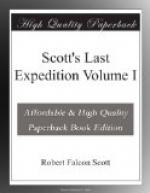Monday, August 28.—Ponting and Gran went round the bergs late last night. On returning they saw a dog coming over the floe from the north. The animal rushed towards and leapt about them with every sign of intense joy. Then they realised that it was our long lost Julick.
His mane was crusted with blood and he smelt strongly of seal blubber—his stomach was full, but the sharpness of back-bone showed that this condition had only been temporary, daylight he looks very fit and strong, and he is evidently very pleased to be home again.
We are absolutely at a loss to account for his adventures. It is exactly a month since he was missed—what on earth can have happened to him all this time? One would give a great deal to hear his tale. Everything is against the theory that he was a wilful absentee—his previous habits and his joy at getting back. If he wished to get back, he cannot have been lost anywhere in the neighbourhood, for, as Meares says, the barking of the station dogs can be heard at least 7 or 8 miles away in calm weather, besides which there are tracks everywhere and unmistakable landmarks to guide man or beast. I cannot but think the animal has been cut off, but this can only have happened by his being carried away on broken sea ice, and as far as we know the open water has never been nearer than 10 or 12 miles at the least. It is another enigma.
On Saturday last a balloon was sent up. The thread was found broken a mile away. Bowers and Simpson walked many miles in search of the instrument, but could find no trace of it. The theory now propounded is that if there is strong differential movement in air currents, the thread is not strong enough to stand the strain as the balloon passes from one current to another. It is amazing, and forces the employment of a new system. It is now proposed to discard the thread and attach the instrument to a flag and staff, which it is hoped will plant itself in the snow on falling.
The sun is shining into the hut windows—already sunbeams rest on the opposite walls.
I have mentioned the curious cones which are the conspicuous feature of our Ramp scenery—they stand from 8 to 20 feet in height, some irregular, but a number quite perfectly conical in outline. To-day Taylor and Gran took pick and crowbar and started to dig into one of the smaller ones. After removing a certain amount of loose rubble they came on solid rock, kenyte, having two or three irregular cracks traversing the exposed surface. It was only with great trouble they removed one or two of the smallest fragments severed by these cracks. There was no sign of ice. This gives a great ‘leg up’ to the ‘debris’ cone theory.
Demetri and Clissold took two small teams of dogs to Cape Royds to-day. They found some dog footprints near the hut, but think these were not made by Julick. Demetri points far to the west as the scene of that animal’s adventures. Parties from C. Royds always bring a number of illustrated papers which must have been brought down by the Nimrod on her last visit. The ostensible object is to provide amusement for our Russian companions, but as a matter of fact everyone finds them interesting.




